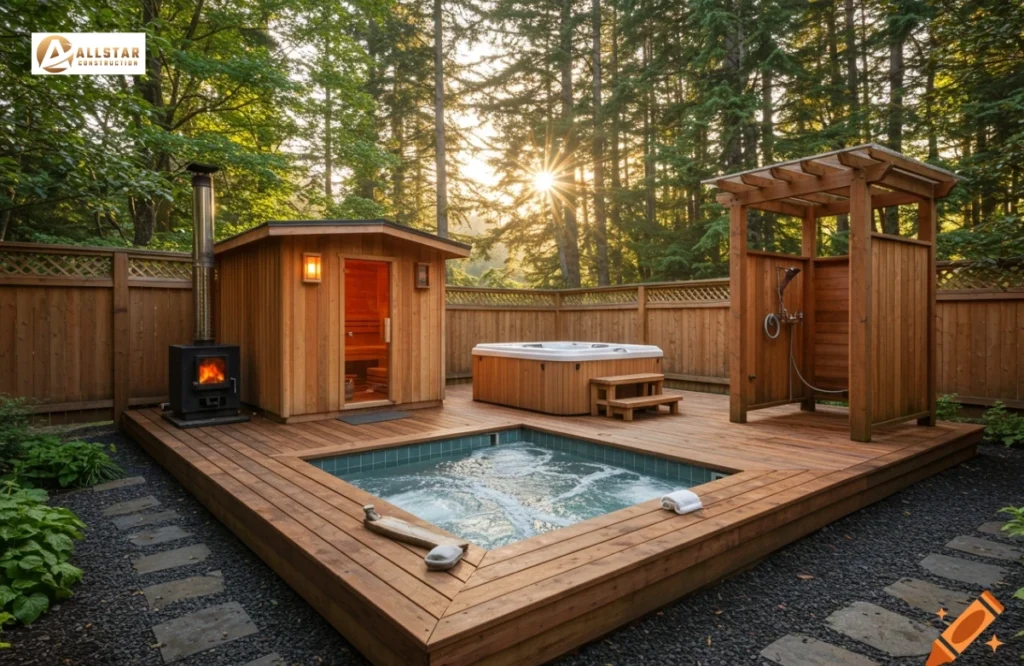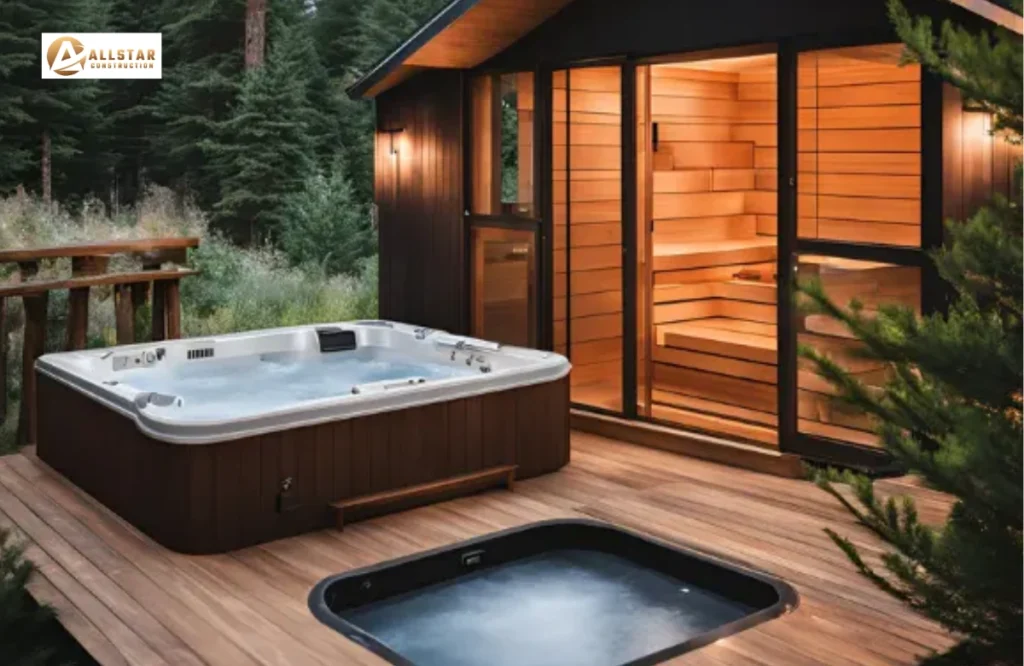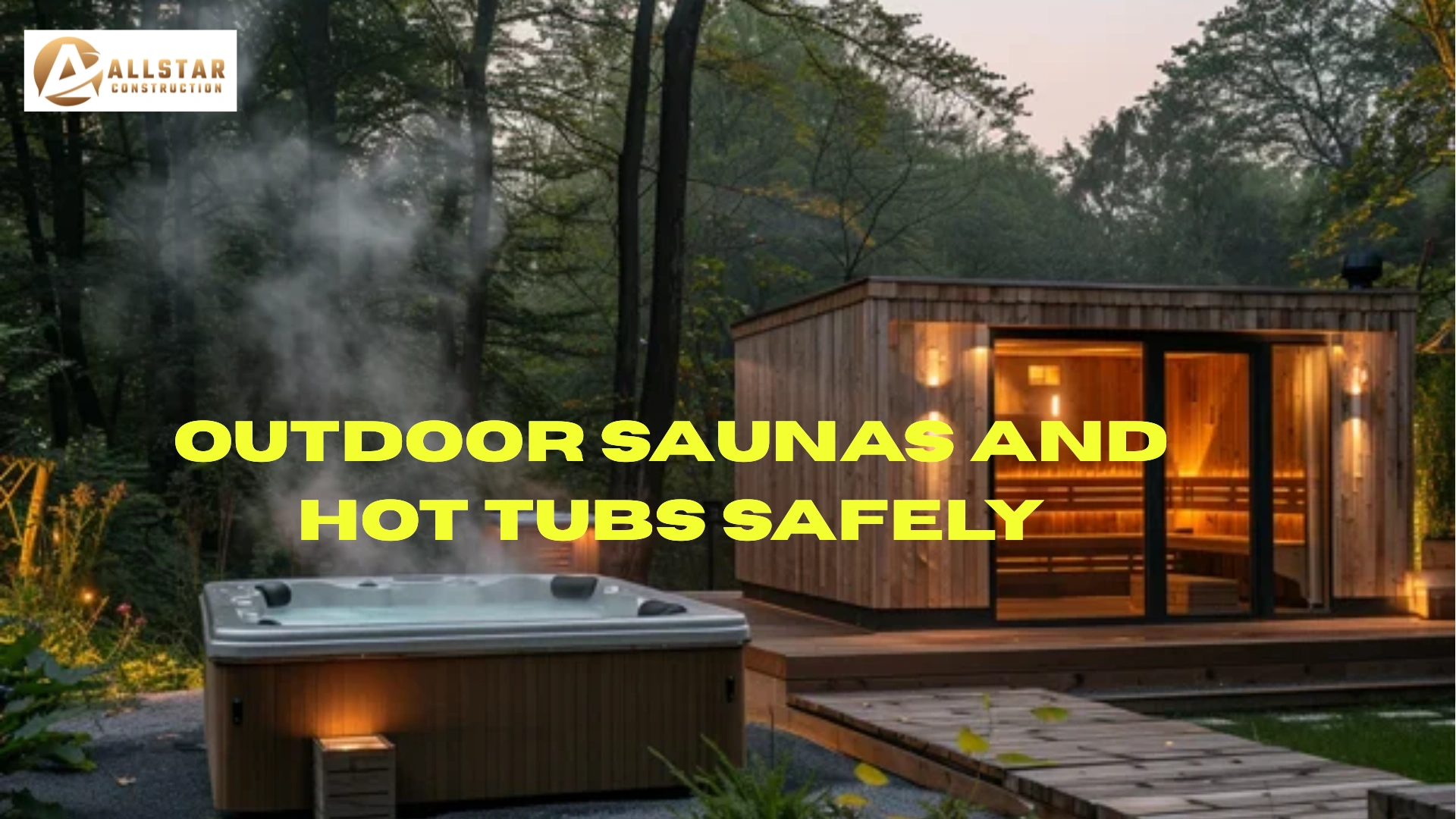There is nothing like getting into a hot sauna or a hot tub after a long day. These are not just luxuries, but backyard wellness areas that are also places of relaxation, stress relief, and fitness.
You can make it even more wonderful when you add an outdoor sauna and a hot tub. However, the concept may be straightforward, but the process of their safe establishment is to be thought through. Electrical work to drainage and weatherproofing, it is all in the details to make your retreat safe and enjoyable.
Why Saunas and Hot Tubs Make the Perfect Pair
Hot tubs and saunas are two things that go hand in hand. A sauna heats the muscles, sweats out toxic substances and soothes the body. The presence of a hot tub means there is hydrotherapy and sore joints are relieved, as well as facilitated circulation. They are all a complete cycle of wellness: heat, cool-down, soak, repeat.
Importance of Safe Installation and Integration
To match these two systems together, it is necessary to do more than putting them next to each other. They both touch on heat, water and electricity- factoring that can be hazardous as far as not planned. Not only is the safe installation a guarantee of your enjoyment, but the reliability and defense against hazards in the long term.
Overview of Key Safety Considerations
Before wiring your sauna and your hot tub, you should consider:
- Electrical safety: Grounding, proper circuits and GFCI.
- Structural planning: Location, drainage and access.
- Environmental factors: Weatherproofing, ventilation, climatic issues.
Planning the Layout: Sauna and Hot Tub Placement Tips
Ensuring Proper Distance and Accessibility
You will desire the sauna and hot tub to be in close proximity so that they are available but not too close to one another to cause interference. Provide enough space (at least 3-5 feet) to move freely and route electrical safely. Ensure that there are steps, handrails and non-slip surfaces that can be used to exit and enter the premises.
Considering Terrain, Drainage, and Weather Exposure
Well-drained flat ground would be best. Do not take low areas where rainwater stands. Consider the direction of the wind, the direction of the sun, and privacy when deciding on where to sit. By positioning the sauna close to a windbreak or a partial shade, the lifetime of the sauna can be prolonged.

Local Building Codes and Zoning Rules to Keep in Mind
Verify the building codes of your city to do the groundwork. There are regions where it is necessary to have the electric work permitted or there is a limit on the amount of water to use. Adherence to codes secures your installation to pass inspections and be able to avoid fines in the future.
Electrical Safety Essentials
Understanding Power Requirements (Amps, Voltage, Dedicated Circuits)
Saunas and hot tubs are power-consuming. A majority of hot tubs should have a hardwired circuit of 220-240 V, but small infrared saunas can operate on 120 V. Ever attempt to run them simultaneously. Specific circuits eliminate overloading and lessen fire hazard.
GFCI (Ground Fault Circuit Interrupter) Protection
GFCI protection is required because of the presence of water and electricity. GFCI breaker cuts off the power immediately when it detects the slightest electrical leak, to prevent shocks to you.
Working With a Licensed Electrician
Wiring could be cheaper in the short-run, but it is not worth the risk. An electrician will make sure that wiring is done to code, circuits are balanced, and that everything is properly grounded by a licensed electrician. They will also be aware of how to install outdoor living rated outlets and conduits.
Running Underground Cables Safely Between Units
When you have a long distance between your sauna and your hot tub, it might be needed to have underground wiring. The cables should be buried at the right depth ( 18-24 inches) and enclosed with waterproof conduit. Alway write the route so as not to dig yourself in unintentionally in future.
Plumbing and Drainage Considerations
Proper Water Supply and Drainage for Hot Tubs
Hot tubs must have a continuous flow of water and they need to be drained and cleaned. It is also important to ensure that the drain is not toward the sauna or foundation of your house as it may flood.
Moisture Control Around the Sauna Area
Saunas do not need plumbing, although any accumulation of moisture outside can cause a problem with mould or structural damage. Fit in right drainage on the floor or gravel under the sauna to allow water to drain out.
Avoiding Cross-Contamination Between Systems
The treated water in a hot tub should not be kept in the same place as the sauna. Do not use the hot pool water in the sauna as steam because it has chemicals which are not safe to inhale.
Climate and Weatherproofing Tips
Insulating Pipes and Electrical Lines
Weather strip all open pipes and electrical conductors in colder areas. This will avoid freezing, cracking and power problems in winter.
Roof Overhangs, Wind Blocks, and Snow Load Planning
Equipment is covered under rain and snow by adding a small roof overhang or pergola. In case where you are in snowy regions, ensure that roofs and buildings are strong enough to carry significant weight. Fences or hedges are wind blocks that provide privacy and minimise weather stress.
Winterization Tips for Cold Climates
Later in winter, when you are not going to use your hot tub, empty it and turn off the electric power. In the case of saunas, doors and windows should have check seals to stop heat leakage and destruction.
Ventilation and Airflow
Preventing Mold and Moisture Build-Up Around Sauna Area
Moisture that is held around the sauna may cause an occurrence of molds. Use the space in alignment with ventilation, and do not make the space too tight.
Natural vs. Mechanical Ventilation Options
Natural airflow is when the sauna is in an open space. Mechanical vents and fans might be necessary in enclosed patios or partially covered spaces so that the air can move correctly.
Ensuring Adequate Space Around Equipment for Air Circulation
Both the saunas and the hot tubs produce heat and moisture. Allow room to circulate the air around each unit–not less than 12 inches.
Safety Around Water and Heat
Non-Slip Surfaces and Step Safety
Wet areas can be slippery. Reduce slips with textured pavers, rubber mats or treated wood decking. Handrailed sturdy steps are added to provide safety.
Safe Entry and Exit Paths Between Sauna and Hot Tub
Prepare a well-lit way between them. There should be no sharp corners, clutters or uneven grounds. Take into account warm routes in wintry weather.
Managing Heat Exposure and Time Limits for Use
It’s easy to overdo it. Restrict time spent in the saunas to 15-20 minutes and in the hot tubs to 20-30 minutes. Also, it is important to remain hydrated and never combine alcohol with the sauna or hot tub session.

Optional Integration Features
Smart Controls for Temperature and Lighting
Smart controls can be matched with the modern saunas and hot tubs. Control the lighting, change temperatures and set timers with your phone.
Outdoor Showers and Changing Areas
Convenience is added with a small shower or changing hut. Take a shower before taking the hot tub to maintain the cleanliness of water.
Lighting for Nighttime Use and Ambiance
Convenience is added with a small shower or changing hut. Take a shower before taking the hot tub to maintain the cleanliness of water.
Benefits of Connecting Saunas and Hot Tubs Safely
- Peace of mind knowing your setup is safe from electrical or structural risks.
- Proper weatherproofing and drainage will provide longer equipment life.
- Reduce maintenance expenses by avoiding water damage, mold or electricity problems.
- Better fun with safe, convenient, and beautiful backyard design.
- More healthful experience without the probability of contamination or overheating.
Conclusion
A sauna and hot tub combination in your back yard can make your own wellness retreat that is as good as a spa. However, in order to enjoy it, one should be safe. Electrical planning, drainage, weatherproofing, and ventilation are all carefully set up so that you can take a seat back and relax.
It would be the best investment you would make by hiring licensed professionals to handle electrical and plumbing assignments. Cleaning, maintaining and frequent checkups will help in maintaining your sauna and hot tubs safe and viable over the years. When it all falls into place, you can have the full experience of the heat, relaxation and health benefits without any doubt.
To explore more, visit All Star Construction Group.
FAQs
In many areas, yes. It is always good to consult with your local building department.
Always leave 3-5 feet space as a safe distance and good air circulation.
After every 3-4 months (depending on the use and the quality of water).
Yes, provided that they get weatherproofed and fitted with electrical systems that can withstand the outdoors.
Stone pavers, composite decking, or treated wood which do not slip or are resistant to water.


